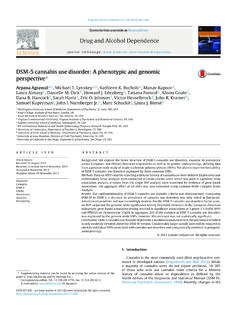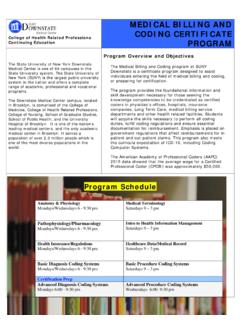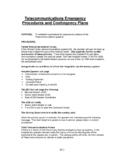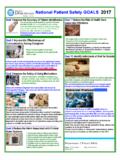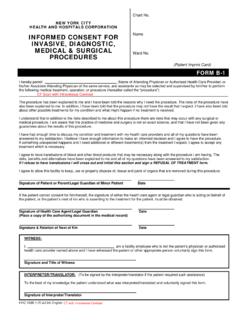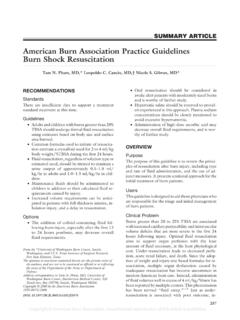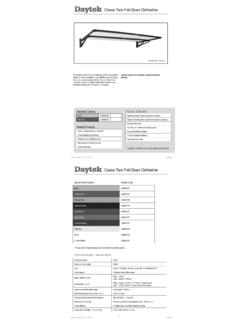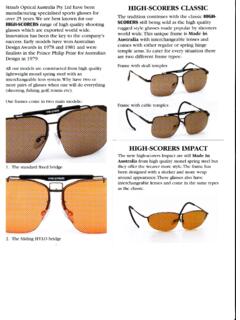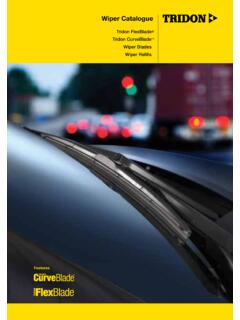Transcription of Techniques for reduction of anteroinferior shoulder ...
1 Emergency Medicine Australasia (2005) 17 , 463 471 Blackwell Science, LtdOxford, UKEMME mergency Medicine Australasia1035-68512005 Blackwell Publishing Asia pty ltd 2005175463471 Review Article anteroinferior shoulder dislocationNJ Cunningham Correspondence:Dr Neil J Cunningham, Department of Emergency Medicine, St Vincent s Hospital, Victoria Parade, Fitzroy, Vic. 3065, Australia. Email: J Cunningham, MB BS, Registrar. R EVIEW A RTICLE Techniques for reduction of anteroinferior shoulder dislocation Neil J Cunningham Department of Emergency Medicine, St Vincent s Hospital, Fitzroy, Victoria, Australia Abstract Dislocation of the shoulder joint is common.
2 The shoulder is affected in up to 60% of allmajor joint dislocations, one study citing an incidence of in the general most common form is anteroinferior dislocation. A variety of Techniques to reduceshoulder dislocation has been described. The key to successful relocation is a thoroughunderstanding of the anatomy of both the enlocated and the dislocated shoulder joint. Key words: dislocation , method , reduction , shoulder , technique. Methodology A comprehensive literature search was performed withthese methods: MEDLINE search using keywords( shoulder , dislocation , reduction , technique , method ) identifying 47 relevant papers; manual searchof bibliographies; scans of abstracts of recent interna-tional meetings; trawl of standard Emergency Medicine,Orthopaedic and Anatomy textbooks.
3 Anatomy of the shoulder The glenohumeral joint is a highly mobile ball andsocket joint. This comes at a cost to stability. Stabilityand resistance to translating forces is provided by:1. The suction cup effect of the labrum. The socket isformed by the shallow glenoid fossa reinforced by afibrous labrum that doubles the depth of the fossaand creates a suction cup effect on the Limited joint volume and negative Static stabilizers: the fibrous labrum is composedof fibrocartilage.
4 The loose joint capsule is rein-forced by rotator cuff tendon insertions. Theglenohumeral ligaments are important anteriorstabilizers providing resistance to anterior transla-tion at different stages of abduction. The inferiorglenohumeral ligament (IGHL) is a complex madeup of anterior and posterior bands with aninterposing pouch. Injury to IGHL complex iscommon in younger patients, leaving the jointunstable. 1,2 4. Dynamic stabilizers: several groups of muscles actover the shoulder joint contributing to separated these into four groups based onlength and insertion onto the humerus, radius andulna.
5 3 Group one is the rotator cuff muscles. Thesemuscles are the most important stabilizers, their ten-dons reinforcing the joint capsule. Group two islarger and more superficial and inserts onto the NJ Cunningham 464proximal humeral shaft. Group three inserts moredistally onto the humerus. Group four is the longestand inserts into the bones of the forearm. Anatomy in dislocation In dislocation the anatomy and inherent stabilitychanges. The humeral head sits in either a subcoracoidor subglenoid position.
6 Return of the humeral head tothe glenoid fossa is confronted by two major obstacles,static and dynamic forces. Static forces The patient classically presents with the humerus inabduction. The arm however, can appear adducted ,because the patient slouches to the affected sidewith the scapula fully rotated and anteverted. Thiscan be felt clinically and seen on X-ray radiograph(Fig. 1). Consequently supralateral to the displacedhead is a fixed obstacle, the prominent anteriorlyplaced glenoid rim and labrum.
7 To relocate fromthis position and move past the glenoid rim thehumeral head must move anteriorly and obstacle is overcome by external rotation of thehumeral head; a greater articular surface on the humeralhead is presented superiorly to the receiving fossaallowing it to roll past the rim. 4 Alternatively rotationof the scapula with retroversion presents an easier pathfor the returning head. Dynamic forces With the humerus in the anatomical position the result-ant force of the shoulder girdle muscles acts to pull thehumeral head and neck in a medial direction.
8 Thedynamic stabilizers normally function to hold the jointin place. However, when the humeral head is displacedthese muscles continue to contract reflexly. Muscularspasm, and therefore shortening, continues to pull thehumeral head (through the tuberosities) and shaftdespite the head being malpositioned. The long head ofbiceps and subscapularis resist reduction of the dis-placed humeral head. 3 Longitudinally directed muscles positioned acrossthe glenohumeral joint, act to pull the humeral headupwards, fixing it in the subcoracoid/glenoid areas.
9 Thelong head of biceps is proximally inserted at the supra-glenoid tubercle and superior labrum, the tendon thenpassing anterior to the humeral head. In spasm thismuscle resists anterior movement of the head. It mightalso have the added effect of bowstringing anterolateralto the axis of the head, further restricting the lateral/supralateral movement of the humeral head required tomove past the glenoid inserts into the lesser tuberosity, act-ing to internally rotate the humerus and hold the headmedially, resisting lateral movement.
10 Spasm of thismuscle also restricts the external rotation required forreduction. Types of dislocation There are four types of anteroinferior shoulder disloca-tion, denoted by the final position of the humeral dislocations constitute 70% of all disloca-tions. 5,6 Subglenoid dislocations (Fig. 2) are the secondmost common, 30%. 5 Subclavicular and intrathoracicdislocations are associated with fractures and violentforces. 7 Luxatio erectae is regarded as a pure inferiordislocation and is not discussed here.
